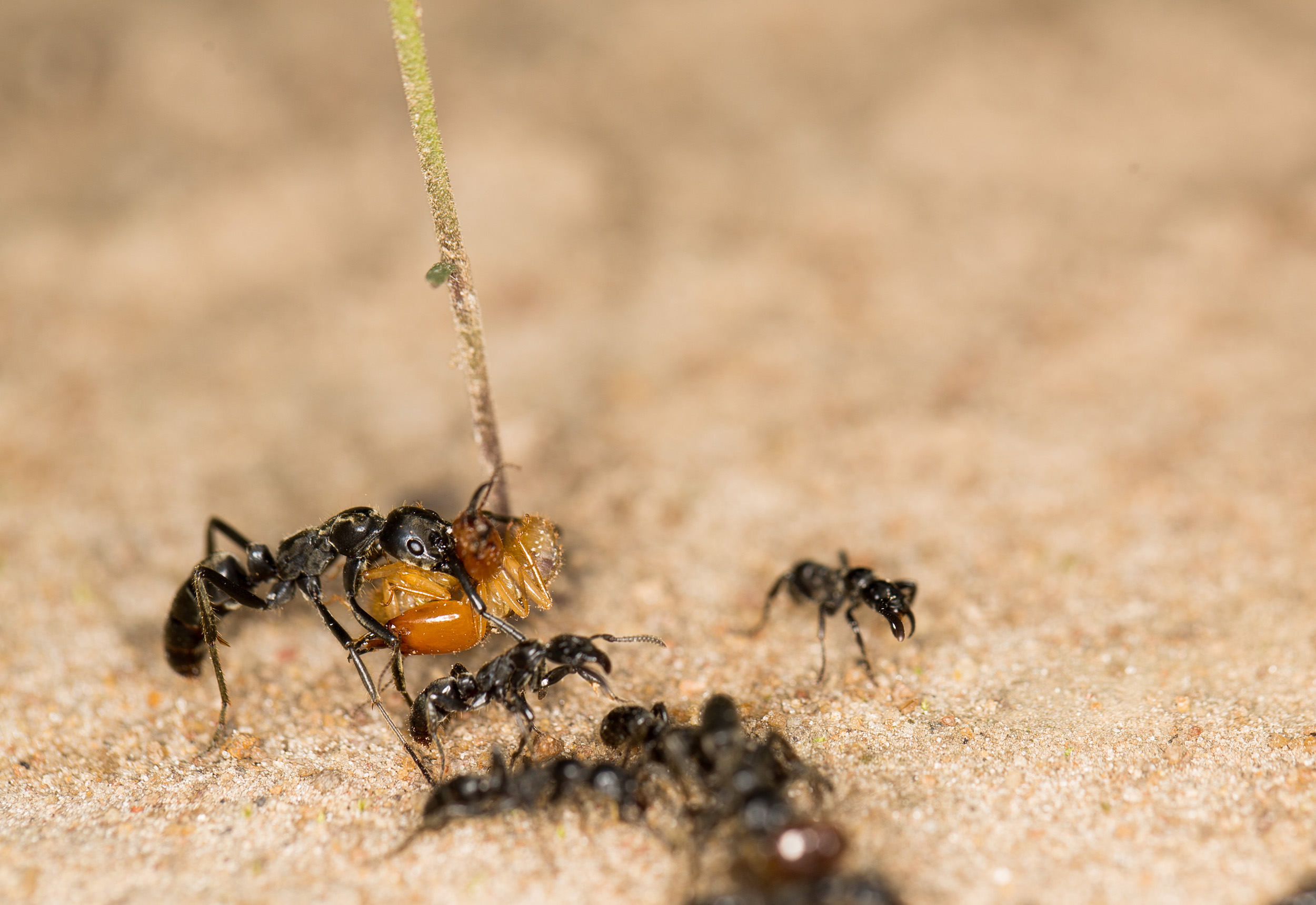 Evolution & Behaviour
Evolution & Behaviour
Ant medics: wound treatment in a predatory species
Matabele ants often get injured and loose limbs while hunting termites. Inside the nest, we observe nestmates treating these wounds. They clean the injury with their mouths and thus reduce the infection risk and mortality of the injured.

When we get injured we treat our wounds. Our skin is an important barrier against pathogens and if it breaks we have to keep it clean. If we are not able to do so ourselves, we go to a doctor to do it for us. This problem is not unique to humans. In insects, the cuticle is the main barrier against pathogens and if it breaks it increases the risk of infections and death significantly. Species that are at high risks of getting injured therefore had to find ways to deal with these injuries. The predatory Matabele ants (Megaponera analis) specializes on only hunting termites in large raiding parties of up to 800 ants. During these hunts, a lot of the ants get injured. Last year we were able to show that these injured ants, after the battle, call for help and get carried back to the nest, thereby rescuing them from predators and a dangerous return journey (read also the break: Saving the injured: The value of rescued veterans in a predatory ant species). We were able to show that these injured ants were then able to recover inside the nest from their injuries and participated again in future fights (if they lost a leg they learned to walk with 4 or 5 legs).
Until now we did not know what exactly was going on inside the nest. How where the ants able to recover from their injuries? How did they deal with the increased infection risk of open wounds?
To answer these questions, we collected colonies from the wild. The ants occur in all of sub-Saharan Africa and the study was carried out in the Comoé National Park (Ivory Coast). We then placed these nests in the research stations laboratory and included infrared cameras that allowed us to film what was going on in these artificial nests.
Inside the nests, we were able to observe some unique behaviours for the first time. The injured ants that had lost a limb were receiving treatment at the wound by their nestmates as soon as they arrived inside the nest. The nestmate would carefully grab the severed leg with their mandibles and front legs and start to intensively lick inside the wound for various minutes.
The obvious question that arose from these observations was: how useful is this "licking"? How does it affect the injured ants' recovery? With careful isolation experiments, we were able to show that ants that had lost a limb would die in 8 out of 10 cases without treatment. But if they received treatment on the wound the mortality would drop to 1 out of 10! This clearly suggested that the treatment was vital for the survival of the injured ants. One remaining question was: what did the treatment actually do then? To test if an infection could be the cause of death without treatment, we kept injured ants in a completely sterile environment with minimal chance of infection, in this case, the mortality was only 2 out of 10. In other words, it looks like the treatment helps keep the wound clean and thereby reduce the risk of an infection killing the ants.
While self-treatment of wounds is relatively well known in the animal kingdom, treatment of the wounds of other individuals is rarely observed and is mostly anecdotal. Making this the first scientific study to truly quantify the value and sophisticated behaviour of treating the wounds of their injured nestmates. There are still a lot of unanswered questions though: Is the treatment of the injuries purely prophylactic (as in just cleaning the injury) or does it involve actual medical treatment (applying antibiotics or other substances to fight off an infection). How do the ants know if a nestmate needs treatment? And is it always the same ants that treat the injured?
In addition, this study is a nice example of how basic research (no apparent direct value for human society, apart from broadening our knowledge of social behaviour in ants), could turn out to be truly valuable for our welfare. If it turns out that the ants are actually treating the wounds with antibiotics we could potentially identify new antibiotics to combat infections. There is a very important value in conducting research just for the sake of expanding our knowledge because you never know what you might find and how it could be useful for us.
Original Article:
E. T. Frank, M. Wehrhahn, K. E. Linsenmair, Wound treatment and selective help in a termite-hunting ant. Proc Biol Sci 285, (2018)Next read: Saving the injured: The value of rescued veterans in a predatory ant species by Erik Frank
Edited by:
Massimo Caine , Founder and Director
We thought you might like
More from Evolution & Behaviour
Cicada emergence alters forest food webs
Jan 31, 2025 in Evolution & Behaviour | 3.5 min read by Martha Weiss , John LillSize does not matter: direct estimations of mutation rates in baleen whales
Jan 29, 2025 in Evolution & Behaviour | 4 min read by Marcos Suárez-MenéndezThe Claws and the Spear: New Evidence of Neanderthal-Cave Lion Interactions
Jan 22, 2025 in Evolution & Behaviour | 3.5 min read by Gabriele RussoA deep-sea spa: the key to the pearl octopus’ success
Jan 20, 2025 in Evolution & Behaviour | 3.5 min read by Jim BarryFeisty fish and birds with attitude: Why does evolution not lead to identical individuals?
Aug 31, 2024 in Evolution & Behaviour | 3 min read by Lukas Eigentler , Klaus Reinhold , David KikuchiEditor's picks
Trending now
Popular topics


